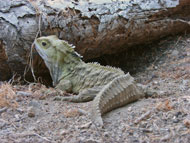Description:
These throwbacks to prehistoric times are in their own separate family; they’re not even a lizard despite their similarity. They survive in just a few remote islands under the coldest conditions of any living reptile – normal active temps are in the 60s, and even high 50s Fahrenheit. If you were to keep them healthy in captivity, you’d have to mimic those conditions, but don’t worry about it – you’ll never own one. They are strictly protected and never allowed out of their home country anymore. Tuataras eat large insects and live in self-constructed burrows on open ground. Their existence is rather sedentary, and entire reproductive history extremely slow at the chill temps they exist in. They still have the ‘third eye’ – the pineal eye that’s light receptive – on top of their heads, the importance of which isn’t really understood. The best, and only opportunity to see them is to travel to new Zealand where new colonies have been established on some small islands that formerly had them and where tourists may see them in the wild. A couple U.S. zoos also have them too, though not necessarily on display to the public.
Habitat:
Open, rocky ground
Range:
A few small islands in New Zealand
Scientific Name: Sphenodon punctatus
Species Group:
Family: Sphenodontidae
Size: To about 2½ feet total length
Level:
Weight:
Dangerous: No


